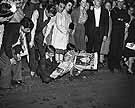
|
|
|

|

|

|

|
|
Click on an image to see a larger, more detailed picture.
|
|
|
|
|
| 1945: Liberation and Rebuilding |

|
pg. 596 |

|
|
|
|
| |
 Residents of Washington, D.C., seek solace from one another on April 12, 1945, as they absorb the news of the death of President Franklin Roosevelt. His little-known successor, Harry Truman, struggled to fill the shoes of the beloved president. Concerned about Jews liberated from the Nazi camps and now confined to displaced-persons camps, Truman pressured the British to allow more Jews to immigrate to Palestine. He also lobbied Congress to permit more displaced persons to enter the U.S. Truman's efforts faced opposition from segments of the public, the State Department, and some congressmen, including Senator Patrick McCarran, the powerful chair of the Senate Judiciary Committee.
Residents of Washington, D.C., seek solace from one another on April 12, 1945, as they absorb the news of the death of President Franklin Roosevelt. His little-known successor, Harry Truman, struggled to fill the shoes of the beloved president. Concerned about Jews liberated from the Nazi camps and now confined to displaced-persons camps, Truman pressured the British to allow more Jews to immigrate to Palestine. He also lobbied Congress to permit more displaced persons to enter the U.S. Truman's efforts faced opposition from segments of the public, the State Department, and some congressmen, including Senator Patrick McCarran, the powerful chair of the Senate Judiciary Committee.
Photo: AP/Wide World
|
 Several Jewish Allied soldiers celebrate a Passover Seder in 1945 at Lake Como in Italy. The Passover annually celebrates the liberation of the Jews from slavery in ancient Egypt. This Passover was especially meaningful for European Jews, since it was the first time in a dozen years that they were not "enslaved" by the Nazis and their collaborators.
Several Jewish Allied soldiers celebrate a Passover Seder in 1945 at Lake Como in Italy. The Passover annually celebrates the liberation of the Jews from slavery in ancient Egypt. This Passover was especially meaningful for European Jews, since it was the first time in a dozen years that they were not "enslaved" by the Nazis and their collaborators.
Photo: Barbara Roth/United States Holocaust Memorial Museum Photo Archive
|
 This necklace in the shape of the Star of David was fashioned by a young Jewish girl--a slave laborer--from bits of colored conduit wire. If she had been discovered with the necklace, she would have been executed. A Nazi transport train that carried her and other laborers (including her ailing sister) was mistakenly attacked and crippled by U.S. planes near Munich. The German troopers fled, leaving the prisoners to the care of a U.S. Army reconnaissance unit. So grateful was the girl that she gave the necklace as a gift to her rescuer, a GI named Marvin Dorf.
This necklace in the shape of the Star of David was fashioned by a young Jewish girl--a slave laborer--from bits of colored conduit wire. If she had been discovered with the necklace, she would have been executed. A Nazi transport train that carried her and other laborers (including her ailing sister) was mistakenly attacked and crippled by U.S. planes near Munich. The German troopers fled, leaving the prisoners to the care of a U.S. Army reconnaissance unit. So grateful was the girl that she gave the necklace as a gift to her rescuer, a GI named Marvin Dorf.
Photo: Marvin Dorf/United States Holocaust Memorial Museum Photo Archive
|
|

|

|

|

|
 Early March 1945: Fifteen-year-old Anne Frank dies at the Bergen-Belsen, Germany, concentration camp.
Early March 1945: Fifteen-year-old Anne Frank dies at the Bergen-Belsen, Germany, concentration camp.
|
 Early March 1945: Arthur Nebe, Einsatzgruppe B commander in Belorussia, is executed by the Nazis because of his involvement in the plot against Hitler.
Early March 1945: Arthur Nebe, Einsatzgruppe B commander in Belorussia, is executed by the Nazis because of his involvement in the plot against Hitler.
|
 March-April 1945: Two thousand inmates from the Köszeg, Hungary, slave-labor camp are marched for weeks through rugged Hungarian and Austrian countrysides.
March-April 1945: Two thousand inmates from the Köszeg, Hungary, slave-labor camp are marched for weeks through rugged Hungarian and Austrian countrysides.
|
 March 3, 1945: An evacuation train from Gross-Rosen, Germany, arrives at the Ebensee, Austria, camp with more than 2000 Jews. More than 180 are killed almost immediately.
March 3, 1945: An evacuation train from Gross-Rosen, Germany, arrives at the Ebensee, Austria, camp with more than 2000 Jews. More than 180 are killed almost immediately.
|
|
|
|
|
| 1945: Liberation and Rebuilding |

|
pg. 596 |

|
|
The Holocaust Chronicle
© 2009 Publications International, Ltd.
|
|
